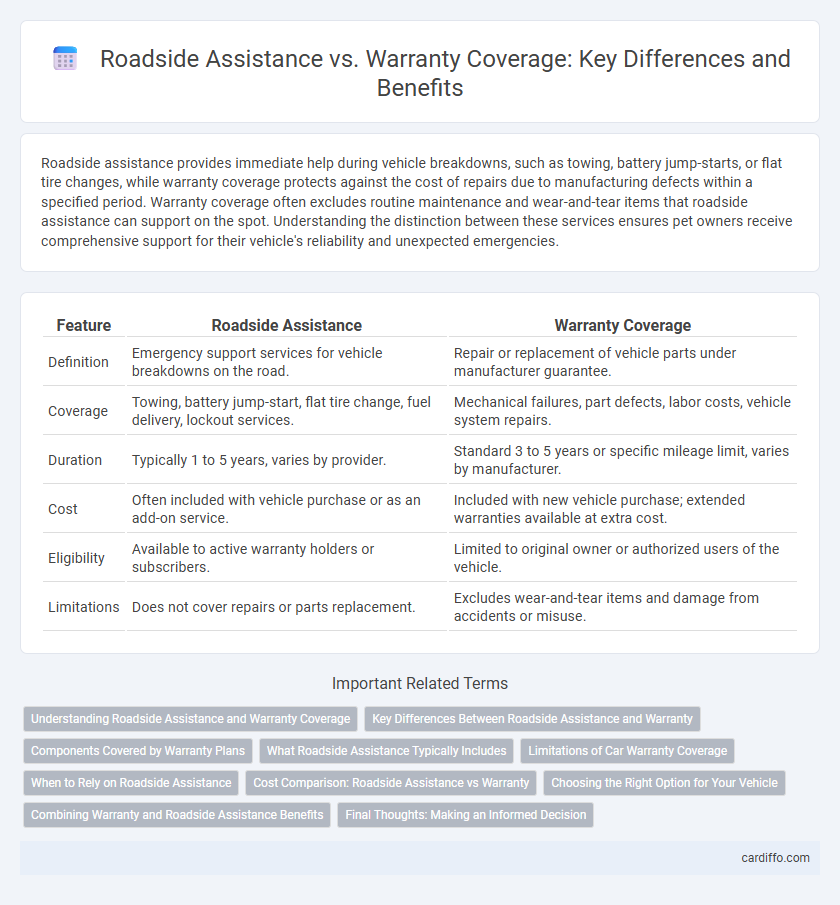Roadside assistance provides immediate help during vehicle breakdowns, such as towing, battery jump-starts, or flat tire changes, while warranty coverage protects against the cost of repairs due to manufacturing defects within a specified period. Warranty coverage often excludes routine maintenance and wear-and-tear items that roadside assistance can support on the spot. Understanding the distinction between these services ensures pet owners receive comprehensive support for their vehicle's reliability and unexpected emergencies.
Table of Comparison
| Feature | Roadside Assistance | Warranty Coverage |
|---|---|---|
| Definition | Emergency support services for vehicle breakdowns on the road. | Repair or replacement of vehicle parts under manufacturer guarantee. |
| Coverage | Towing, battery jump-start, flat tire change, fuel delivery, lockout services. | Mechanical failures, part defects, labor costs, vehicle system repairs. |
| Duration | Typically 1 to 5 years, varies by provider. | Standard 3 to 5 years or specific mileage limit, varies by manufacturer. |
| Cost | Often included with vehicle purchase or as an add-on service. | Included with new vehicle purchase; extended warranties available at extra cost. |
| Eligibility | Available to active warranty holders or subscribers. | Limited to original owner or authorized users of the vehicle. |
| Limitations | Does not cover repairs or parts replacement. | Excludes wear-and-tear items and damage from accidents or misuse. |
Understanding Roadside Assistance and Warranty Coverage
Roadside assistance provides immediate support for vehicle breakdowns such as towing, tire changes, and lockout services, ensuring safety and convenience during unexpected situations. Warranty coverage protects against repair costs due to manufacturer defects or part failures within a specified period or mileage limit. Understanding the distinction helps car owners maximize benefits by utilizing roadside assistance for emergencies and warranty coverage for mechanical repairs.
Key Differences Between Roadside Assistance and Warranty
Roadside assistance provides emergency services such as towing, tire changes, and lockout help, while warranty coverage guarantees repair or replacement of vehicle parts due to defects or malfunctions. Roadside assistance is typically time-bound and usage-based, focusing on immediate vehicle issues, whereas warranty coverage involves long-term protection against manufacturing flaws. Understanding these distinctions helps vehicle owners know when to use roadside help versus making warranty claims.
Components Covered by Warranty Plans
Warranty plans primarily cover repairs or replacements of key vehicle components such as the engine, transmission, and electrical systems, ensuring protection against manufacturing defects. Roadside assistance typically does not cover internal vehicle parts but offers services like towing, battery jump-starts, and flat tire changes. Unlike roadside assistance, warranty coverage guarantees repair costs for specific component failures within the agreed period or mileage limits.
What Roadside Assistance Typically Includes
Roadside assistance typically includes services such as emergency towing, battery jump-starts, flat tire changes, lockout assistance, and fuel delivery, ensuring drivers receive help during unexpected breakdowns. Unlike warranty coverage, which addresses repairs for vehicle defects and mechanical failures, roadside assistance focuses on immediate support to keep drivers safe and mobile. This service is often available as part of an extended warranty or a separate membership program for added convenience and peace of mind.
Limitations of Car Warranty Coverage
Car warranty coverage typically excludes roadside assistance services, limiting help to repairs and replacements of defective parts within a specified period or mileage. Most warranties do not cover towing, emergency fuel delivery, or lockout services, which are usually offered through separate roadside assistance programs. Understanding these limitations is crucial for vehicle owners to avoid unexpected expenses during breakdowns or emergencies.
When to Rely on Roadside Assistance
Roadside assistance is best relied upon for immediate, on-the-spot help with vehicle issues such as flat tires, dead batteries, or lockouts, offering convenience in unexpected roadside emergencies. Warranty coverage typically addresses repairs of manufacturing defects or major component failures within the vehicle under specified terms and duration. Understanding that roadside assistance complements warranty coverage ensures drivers receive timely support during breakdowns without waiting for authorized service repairs.
Cost Comparison: Roadside Assistance vs Warranty
Roadside assistance typically involves a lower upfront cost or subscription fee compared to extended warranty plans, which often carry higher premiums due to comprehensive repair coverage. While warranty coverage generally covers major mechanical repairs and replacements, roadside assistance focuses on emergency services like towing and lockout help, which can incur additional costs if not included. Evaluating the frequency of service needs and potential repair expenses helps determine which option offers better overall cost efficiency.
Choosing the Right Option for Your Vehicle
Roadside assistance provides immediate help for emergencies like towing, flat tires, or dead batteries, while warranty coverage protects against repairs and defects in vehicle components for a specified period. Choosing the right option depends on your driving habits, vehicle age, and the likelihood of breakdowns versus mechanical failures. Comprehensive plans that combine both services offer the best protection and peace of mind for your vehicle's reliability.
Combining Warranty and Roadside Assistance Benefits
Combining warranty coverage with roadside assistance maximizes vehicle protection by ensuring both mechanical repairs and emergency services are included under one plan, reducing unexpected expenses. Warranty coverage typically addresses repair and replacement of parts due to manufacturer defects, while roadside assistance provides immediate help such as towing, fuel delivery, and lockout services. Integrating these benefits enhances overall peace of mind and convenience for vehicle owners by covering a broader range of potential issues on and off the road.
Final Thoughts: Making an Informed Decision
Roadside assistance provides immediate help for vehicle breakdowns such as flat tires or dead batteries, while warranty coverage protects against repair costs for mechanical failures over an extended period. Evaluating your driving habits, vehicle reliability, and repair cost expectations helps determine which option offers the best value. Prioritizing the right balance between emergency support and long-term repair protection ensures informed decision-making for comprehensive vehicle care.
Roadside Assistance vs Warranty Coverage Infographic

 cardiffo.com
cardiffo.com